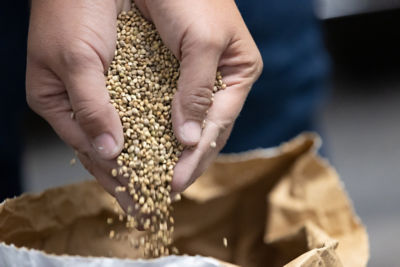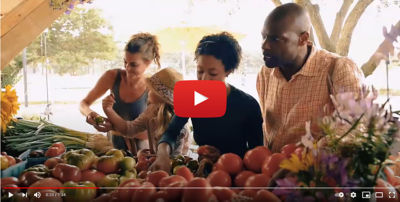Click here to download a PDF version of this Cultivation Insights article.
- Environmental and genetic conditions can disrupt tomato fruit formation resulting in damage that affects the marketability of the fruit.
- Temperature, light, and moisture conditions are often associated with fruit disorders in tomato.
- Managing environmental conditions, selecting tolerant varieties, and providing proper nutrition can help minimize problems with fruit disorders.
Blossom-end rot (BER)
 Figure 1. Symptoms of blossom-end rot. M.E. Bartolo, Bugwood.org.
Figure 1. Symptoms of blossom-end rot. M.E. Bartolo, Bugwood.org.
Symptoms: The initial symptoms of BER include light-tan, water-soaked lesions that form mostly on the blossom ends of green, developing fruit (Figure 1). With time, the lesions become sunken, circular to oblong in shape, and dark brown to black in color with a firm texture. The necrotic tissue is often colonized by black, secondary mold growth.
Causes: BER is the result of a localized calcium deficiency in the blossom end of developing fruit. The low calcium levels do not allow growing cells to form properly. BER often develops as a result of water stress or uneven water availability. Contributing factors include high temperatures and humidity levels, excessive salinity, high nitrogen, potassium, or magnesium levels, watering with water that is too cold, and root damage.
Management: Maintain conditions for even plant growth, especially root growth. Avoid wide water and temperature fluctuations. Keep calcium levels in the nutrient solution at or above 125 ppm. Foliar sprays of calcium chloride or calcium nitrate can help prevent further symptom development. Avoid overly high nitrogen levels and ammonium forms of nitrogen. Use tomato varieties that are tolerant to BER.
Fruit cracking

Symptoms: Concentric cracking (Figure 2) is the splitting of the epidermis in circular patterns around the stem scar. Radial cracking (Figure 3) is splitting that radiates outward from the stem scar. Both concentric and radial cracks occur mostly on fruit as they near maturity. More susceptible varieties start to crack in the mature-green stage. Less susceptible varieties do not start to crack until the breaker or red-ripe stage, and resistant cultivars show little to no cracking.
Causes: Susceptibility to cracking is related to the strength and elasticity of the epidermis of the fruit. Changes in growth rates caused by fluctuations of water, humidity, and temperature (large day/night temperature differences) promote crack formation.
Management: Practices that minimize cracking include proper water management to provide adequate, even levels, and appropriate fertility management (check EC levels) to prevent fruit from becoming over succulent. Proper leaf pruning that minimizes fruit exposure to sunlight helps lower the severity of cracking, as does prevention of defoliation through the management of foliar diseases. Use tomato varieties that are tolerant to cracking.
Splitting

Following exposure to very high temperatures, the skin of fruit can split. The condition can also occur when very cool nights are followed by warm, sunny days. To prevent splitting, keep temperatures low (using shading if needed). Increasing the amount of copper in the nutrient solution up to 2 ppm can also help prevent splitting.
Catface (catfacing)

Symptoms: Fruit with catfacing are misshapen, primarily at the blossom end, with large scars and often holes in the locules (Figure 4). Affected fruit can be kidneyshaped or otherwise severely distorted.
Causes: The cause of catfacing is not well understood. It is believed to be the result of disturbance or damage of flower parts, especially on plants that tend to be more generative. The condition occurs more frequently early in the season on plants with low fruit load and following periods of very high or very low temperatures during early fruit set and formation. Other factors that may contribute to catfacing include high nitrogen levels and extreme fluctuations in day and night temperatures. Catfacing may also be the result of exposure to herbicides such as 2,4-D.
Management: Making sure that the plant is in proper balance by avoiding excessive pruning and excessive nitrogen fertilization may help reduce the severity of catfacing. Low temperatures should be avoided during flowering and fruit formation. Use tomato varieties that are less susceptible to catfacing.
Zippering (zipper scar)

Symptoms: Zippering appears as one or more thin, brown, necrotic scars starting at the stem scar and extending down toward the blossom end of the fruit. Small, transverse scars along the longitudinal scar give the entire scar a zipper-like appearance (Figure 5). Occasionally a hole in the locule will form along the scar.
Cause: Zippering is caused by anthers sticking to the wall of newly forming fruit. Zippering can be caused by low temperatures and slow fruit development. Tomato varieties vary in their susceptibility to zippering.
Sunscald

Symptoms: Large, white areas of necrotic tissue develop on mature-green and breaker-stage fruit (Figure 6). These areas may be surrounded by a yellow halo. The affected tissue becomes sunken and wrinkled.The necrotic tissue can be colonized by secondary black mold fungi. The damage usually appears on the side or tops of tomato fruit.
Cause: Fruit that develop in the shade of the canopy but are suddenly exposed to sunlight can develop sunscald. Sunlight can heat fruit tissue to over 104°F (40°C), which can damage tissue that is not adapted to those conditions. Fruit exposure to sunlight can result from excessive pruning and shifting foliage during harvesting. Defoliation can also result from foliar diseases.
Management: Take care during pruning and harvesting to keep the fruit shaded by leaves. Manage foliar diseases to prevent defoliation. Use tomato varieties that provide good foliar cover for fruit. Applying whitewash to greenhouses or the use of shade cloth can help reduce sunscald. Avoid delays of fruit harvest.
Yellow shoulder

Symptoms: Symptoms of yellow shoulder appear as areas of yellow tissue on the shoulders of ripening fruit (Figure 7). The discoloration may affect the entire shoulder of the fruit or only small, irregular patches. Discoloration usually develops in areas that have been directly exposed to the sun.
Causes: Yellow shoulder is a genetic condition, and susceptibility varies by variety. However, the condition is favored by periods of high light and temperatures. The chlorophyll in the affected areas is slow to breakdown during ripening. The physiological cause of yellow shoulder is not well understood.
Management: The primary way to avoid yellow shoulder is to use tomato varieties that are not susceptible to the condition. Avoid practices, such as excessive pruning, that expose fruit to the sun. Manage foliar diseases and provide adequate levels of phosphorus and potassium.
Sources
BABADOOST, M. 2014. PHYSIOLOGICAL DISORDERS OF TOMATO. REPORT ON PLANT DISEASE NO. 981. UNIVERSITY OF ILLINOIS EXTENSION.
DELAHAUT, K. AND STEVENSON, W. 2004. TOMATO DISORDER: PHYSIOLOGICAL FRUIT PROBLEMS. UNIVERSITY OF WISCONSIN EXTENSION. A3798.
JONES, J., ZITTER, T., MOMOL, T., MILLER, S. 2014. COMPENDIUM OF TOMATO DISEASES AND PESTS. AMERICAN PHYTOPATHOLOGICAL SOCIETY. ST PAUL.
KOIKE, S., GLADDERS P., AND PAULUS, A. 2007. VEGETABLE DISEASES: A COLOR HANDBOOK. ACADEMIC PRESS. BOSTON.
SNYDER, R. 2019. GREENHOUSE TOMATO HANDBOOK. MISSISSIPPI STATE UNIVERSITY EXTENSION SERVICE. P1828
Additional Information
FOR ADDITIONAL AGRONOMIC INFORMATION, PLEASE CONTACT YOUR LOCAL SEED REPRESENTATIVE.
PERFORMANCE MAY VARY, FROM LOCATION TO LOCATION AND FROM YEAR TO YEAR, AS LOCAL GROWING, SOIL AND WEATHER CONDITIONS MAY VARY. GROWERS SHOULD EVALUATE DATA FROM MULTIPLE LOCATIONS AND YEARS WHENEVER POSSIBLE AND SHOULD CONSIDER THE IMPACTS OF THESE CONDITIONS ON THE GROWER’S FIELDS. THE RECOMMENDATIONS IN THIS ARTICLE ARE BASED UPON INFORMATION OBTAINED FROM THE CITED SOURCES AND SHOULD BE USED AS A QUICK REFERENCE FOR INFORMATION ABOUT GREENHOUSE TOMATO PRODUCTION. THE CONTENT OF THIS ARTICLE SHOULD NOT BE SUBSTITUTED FOR THE PROFESSIONAL OPINION OF A PRODUCER, GROWER, AGRONOMIST, PATHOLOGIST AND SIMILAR PROFESSIONAL DEALING WITH THIS SPECIFIC CROP.
BAYER GROUP DOES NOT WARRANT THE ACCURACY OF ANY INFORMATION OR TECHNICAL ADVICE PROVIDED HEREIN AND DISCLAIMS ALL LIABILITY FOR ANY CLAIM INVOLVING SUCH INFORMATION OR ADVICE.
9068_DR_S6 PUBLISHED 02-19-2020
BAYER, BAYER CROSS DESIGN, AND DE RUITER® ARE REGISTERED TRADEMARKS OF BAYER GROUP. ALL OTHER TRADEMARKS ARE THE PROPERTY OF THEIR RESPECTIVE OWNERS. ©2020 BAYER GROUP. ALL RIGHTS RESERVED



